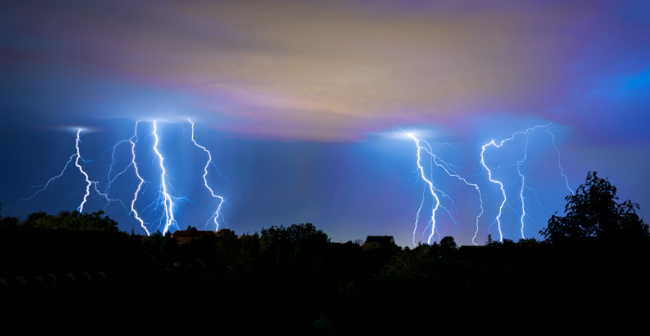Is Lightning Static Electricity?
Lightning is a fascinating phenomenon, illuminating the sky on dark, stormy nights with a sharp burst of light. While it is an amazing occurrence, what causes it, and why is it so important? Is lightning static electricity? How can lightning be beneficial for the earth? What are the dangers of lightning static electricity?
These are excellent questions, which this article addresses in detail. If you’re interested in lightning and if it’s genuinely static electricity, continue reading to learn more!
What Is Static Electricity?
Static electricity is an ordinary electric occurrence where charged particles transfer from one body to another. It happens due to an imbalance between positive and negative charges in an object. When the charges in an object are balanced, the object is neutral. Opposite charges attract each other, while positive charges repel each other.
For example, you may notice your hair sticking up, hovering in a suspended state after taking your hat off in the winter. The strands try to get as far away from each other as possible since they have the same charge. Or perhaps you pet your dog or touch another person’s arm, only to be greeted by a short zap. These are a few common examples of static electricity.
How Does Static Electricity Build Up?
All tangible objects are composed of atoms, containing protons, electrons, and neutrons. The atom’s protons are positively charged, neutrons are neutral, and electrons are negatively charged. Thus, all things are composed of charges.
When there’s an imbalance between an object's negative and positive charges, the result is static electricity. The charges accumulate on the surface of an object until they find a method of release or discharge. One way to discharge the imbalance is via a circuit, which could happen in the abovementioned ways.
Static electricity builds up by collecting these charges on the surface of an object. For example, rubbing your shoe on the carpet transfers extra electrons to your body. They cling to you until they can be released. For example, when you touch your dog, the shock you feel is the transfer of surplus electrons being released from you to your furry friend.
Is Lightning Static Electricity? - Simple Explanation
Lightning is static electricity, just a larger version of the small burst of electricity you transfer to unsuspecting siblings or pets—the general concept of how lightning forms is just like its miniature relative.
Within a storm cloud, ice and water molecules are jostling around, bumping into each other and creating an electrical charge. The positive charges hang out at the top of the cloud, and negative charges gather at the bottom of the cloud.
The low hanging negative charges attract the positive particles on the ground. The positive charges strive to find the path of least resistance to reach the negatively charged particles. This is why tall objects, like trees, buildings, or even people, are victims of lightning strikes.
Once the charge builds up enough, lightning forms as these charges grow big enough to spark within the cloud or even down to connect with the ground’s positive charge.
Benefits of Lightning Static Electricity
The powerful snap of lightning is a spellbinding display of natural electrostatics. Although lightning may seem highly destructive and dangerous, as it can cause catastrophic fires and even result in death, it’s beneficial to the earth.
Lightning’s most significant benefit to the earth is its ability to separate nitrogen from the air. Why is this important? Every year, around 10 million tons of nitrogen are deposited into the soil, which provides abundant natural fertilizer to the ground below.
Forest fires at the hands of lightning don’t seem like a blessing, but it helps rid the forests of old-growth. The absence of old-growth makes room for new saplings to take root, helping rejuvenate the forest. Although forest fires wreak havoc on the forest, creating a swath of destruction in their wake, they help prepare the area for new life.
Dangers of Lightning Static Electricity
Lightning static electricity can be highly hazardous for several reasons. Electric shock resulting from lightning striking a person can cause a flow of current through the body. The results may be as minor as an uncomfortable zap to more severe outcomes such as falls, burns, or stopping the heart.
On the other hand, lightning’s static shock may damage property. If it comes in contact with flammable or explosive mixtures, it may cause ignition, resulting in a fire or explosion. Lightning may also cause production disturbances in processing plants, damage to electrical equipment (damage via electrostatic discharge), or mechanical components.
Generally, sparks are the culprit, responsible for the majority of industrial fires and explosions ignited as a result of static electricity. How does it happen? The spark itself is a discharge of static electricity between two conductors. For example, you may have noticed a spark pop from a key or your finger to a metallic grounded object after you’ve walked across the carpet.
The spark discharges when the accumulated charges on the conductive objects create an electrical field that surpasses the ambient electric strength of the atmosphere. Objects that aren’t grounded can retain a substantial amount of electrostatic charge, but those that are grounded are incapable of such.
To prevent sparks effectively, individuals can connect all objects to a conductor and the earth. This is called bonding (connection to the conductor) and grounding (connection to the earth). Bonding securely joins metallic parts, thus forming an electrically conductive path. This drops their voltage difference to nearly zero. Then, grounding connects the objects to the earth, thus allowing electrostatic electricity to discharge to the ground.
Conclusion
Lightning is a fascinating display of electrostatics at work in nature. The concept of how it forms and develops is relatively simple, although the specifics and technicalities of the topic can be complex. Ultimately, at its most basic form, static electricity is simply the release of an imbalance between positive and negative charges of a particle.
Although lightning offers a unique beauty, it is hazardous, so adhering to proper precautions is essential.




